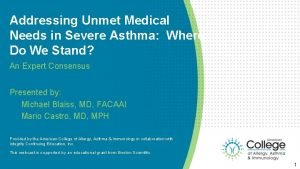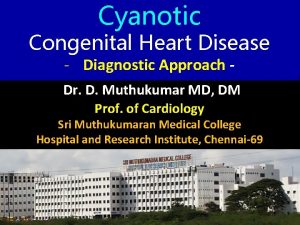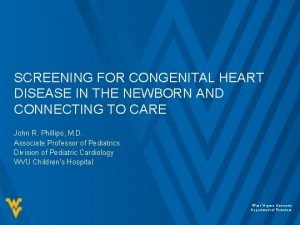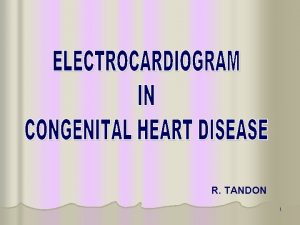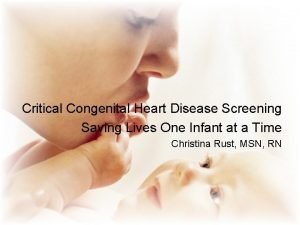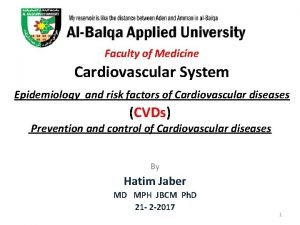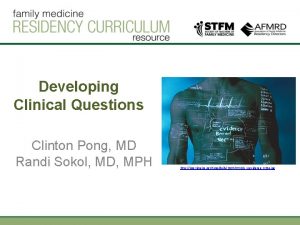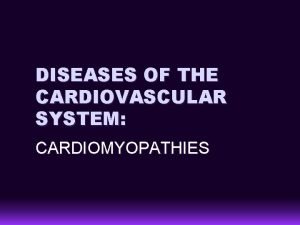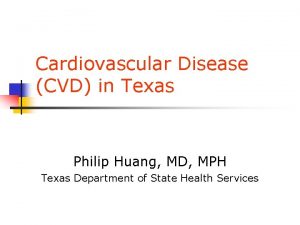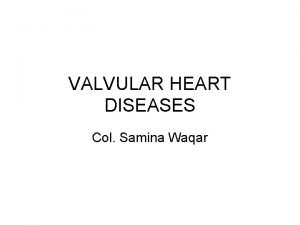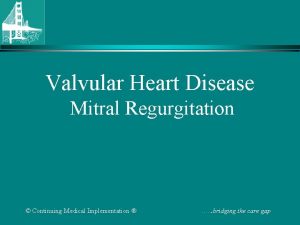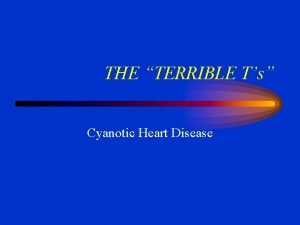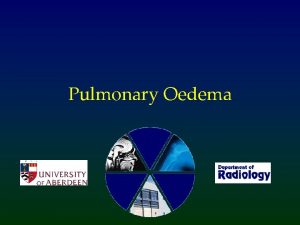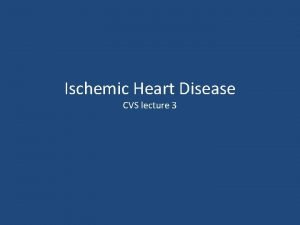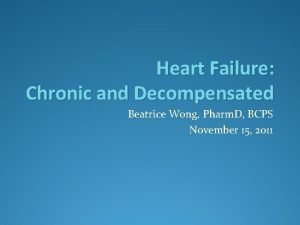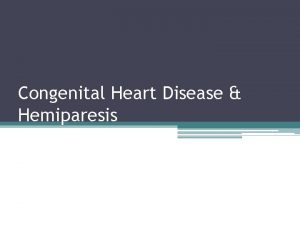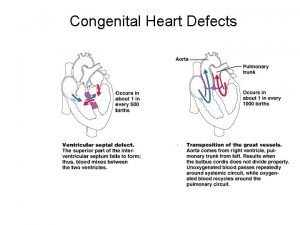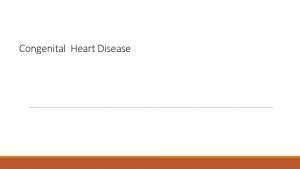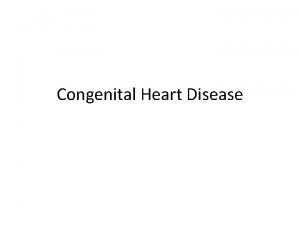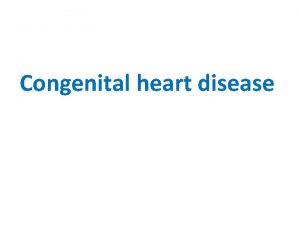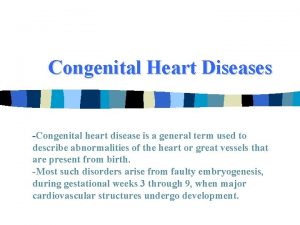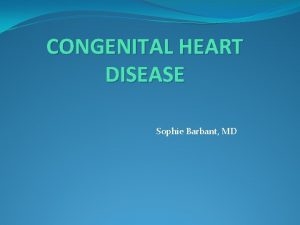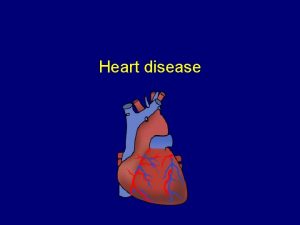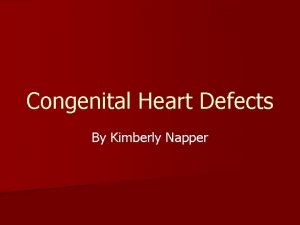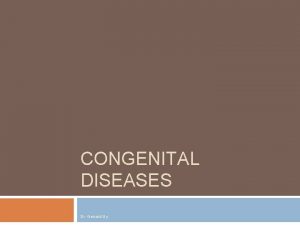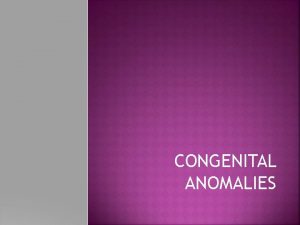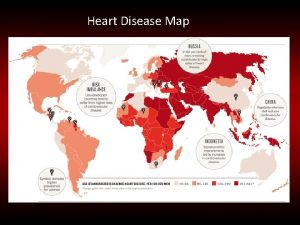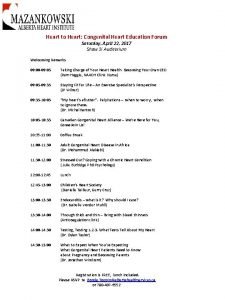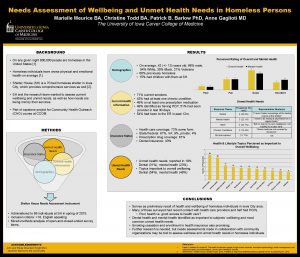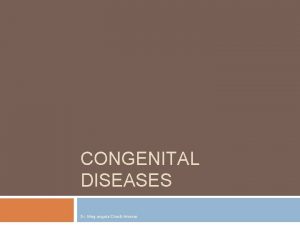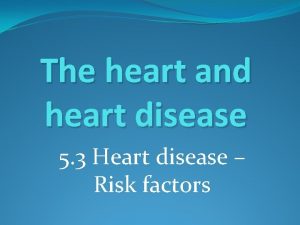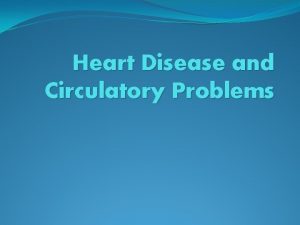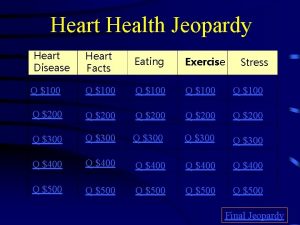Disease States Devices and Unmet Needs Congenital Heart



























- Slides: 27

Disease States, Devices, and Unmet Needs Congenital Heart Disease Thomas J. Forbes, MD, FACC, FSCAI Professor Pediatrics-Wayne State University Co-Director Cardiac Catheterization lab-CHM Co-Director Structural Heart Center-DMC Detroit, MI

Consultant Gore Medical, Flagstaff, AZ St. Jude Medical, Mpls, MN B. Braun Medical, Bethleham, PA Nu. Med Corp, Hopkington, NY Siemens Medical, Chicago, Ill Medtronic Corp, Mpls, MN Bio. Sense Webster, Terumo Corp, Tuzcan, CA Proctor Gore Medical St. Jude Medical B. Braun Medical Biosense Webster

Really two main unmet needs Developing Devices Generational Improvement on Currently Approved Devices

Really two main unmet needs Appreciation to the STS & CCISC Databases STS reported the top 5 cases performed in infants, children, and adults CCISC Database asked physicians “what are the top 5 most important devices that need to be developed for our patients”?

Developing Devices Adults From the STS Database as of February 2016 What is the MOST common surgical procedure in Adults with Congenital Heart Disease?

Developing Devices Adults The most common cyanotic heart defect is Tetralogy of Fallot The most common cyanotic heart defect that makes it into adulthood=Tetralogy of Fallot The most common repair of Tetralogy of Fallot

Developing Devices Adults

Limitations of Current Valve Stents Sapien XT Max ID 29 mm Max OD 31. 3 mm Melody Max ID 24 mm Max OD 25. 7 mm

Developing Devices Adults

Developing Devices Adults ”One way to skin a cat”

Developing Devices Adults ”Another way to skin a cat” Both ways are very $$$$ Melody Valve with Ensemble Delivery=$28, 500 each Catheterization procedure/Hospitalization $15, 000 Patient was in Hospital for procedure 20 hours $3, 600/hour or $60/min or $1/second

Developing Devices Adults STS Database 5 most common procedures in the US in Adults born with Congenital Heart Disease 1&2. Pulmonary Valve Replacement 3. Tricuspid Valve Repair/Replacement 4. Patch Repair of ASD 5. Aortic Aneurysm Repair 6. Mitral Valve Replacement

Developing Devices Adults CCISC Database (104 Responders from 81 Institutions) 2 most needed devices for procedures in the US in Adults born with Congenital Heart Disease 1. Pulmonary Valve expansion capabilities between 26 -44 mm in native outflow tracts 2. Covered Stents for RVOT mishaps and Coarctation of the Aorta

Developing Devices Children STS Database 5 most common procedures in the US in Children born with Congenital Heart Disease 1. ASD Patch Repair 2. Fontan completion 3. VSD repair, Patch 4 -6. Mitral Valvuloplasty-Repair/RVOT procedure/Aortic Valve Replacement

Where are the improvements? Atrial Septal Occluder Devices St. Jude Amplatzer Septal Occluder Approved December 2001 Gore Helex Septal Occluder Approved September 2006

Tale of two valves Sapien Transcatheter Aortic Valve PMA Nov 2 nd, 2011 PMA for XT version June 2014 PMA Sapien 3 THC June 2015 Melody Valve CE Mark Oct 2006 HDE approval Jan 2010 PMA Jan 2015

Developing Devices Children CCISC Database (104 Responders from 81 Institutions) 5 most needed devices for procedures in the US in Children born with Congenital Heart Disease 1. Covered Stents for RVOT mishaps and Coarctation of the Aorta 2. Pulmonary Valve expansion capabilities between 26 -44 mm in native outflow tracts 3. Perimembranous VSD devices 4. Bioabsorbable Stents 5. Improved Cardiac Support Technologies

What is the most common procedure performed in INFANTS congenital heart disease?

Patent Ductus Arteriosus Ligation and Division

What is the second most common procedure performed in INFANTS congenital heart disease?

Patent Ductus Arteriosus Ligation and Division

What is the third most common procedure performed in INFANTS congenital heart disease?

What is the third most common procedure performed in INFANTS congenital heart disease?

Patch Closure of Perimembranous/High Muscular VSD’s

Developing Devices Infants STS Database 5 most common procedures in the US in Children born with Congenital Heart Disease 1. 2. PDA Ligation and Division 3. VSD repair, Patch 4. Complete AV canal repair 5. Tetralogy of Fallot repair

Developing Devices Infants CCISC Database (104 Responders from 81 Institutions) 5 most needed devices for procedures in the US in Infants born with Congenital Heart Disease 1. Bioabsorbable Stents for Pulmonary Artery Stenosis and Neonatal Coarctation of the Aorta 2. PDA devices 3 Fr or smaller for Premie Ductuses 3. Perimembranous VSD devices 4. Get a bare metal stent approved anywhere in the vascular system 5. Improvement of current technology

Developing Devices There were two very important underlying issues regarding unmet needs brought up with the CCISC survey 1. Obtaining approval of devices that would significantly impact procedures in the catheterization lab 2. Creating a culture where generational improvements of currently used devices is encouraged in the pediatric market
 Unmet needs in severe asthma
Unmet needs in severe asthma Cyanotic congenital heart disease
Cyanotic congenital heart disease Tetralogy of fallot xray
Tetralogy of fallot xray Knee chest position
Knee chest position Farah garmany
Farah garmany Unmet financial need
Unmet financial need Canadian congenital heart alliance
Canadian congenital heart alliance Congenital heart
Congenital heart Congenital heart defect
Congenital heart defect Bharathi viswanathan
Bharathi viswanathan Primary needs and secondary needs
Primary needs and secondary needs Satisfaction
Satisfaction Simple claustral complex
Simple claustral complex Strategic gender needs and practical gender needs
Strategic gender needs and practical gender needs Need analysis esp
Need analysis esp Cvds
Cvds Heart disease symptoms
Heart disease symptoms Randi sokol
Randi sokol Ronaldo heart
Ronaldo heart Hypertrophic cardiomyopathy
Hypertrophic cardiomyopathy Heart disease data
Heart disease data Samina waqar
Samina waqar Pathophysiology of valvular heart disease
Pathophysiology of valvular heart disease Mitral stenosis severity
Mitral stenosis severity Terrible t's cyanotic heart disease
Terrible t's cyanotic heart disease Upper lobe diversion
Upper lobe diversion Pathophysiology of ischemic heart disease
Pathophysiology of ischemic heart disease Dopamine uses
Dopamine uses
